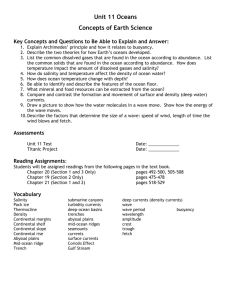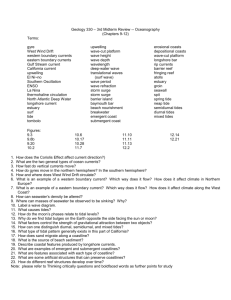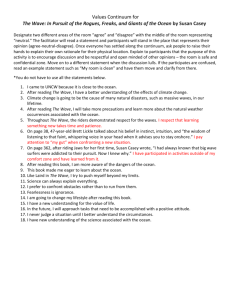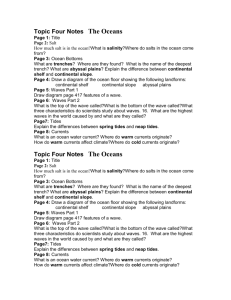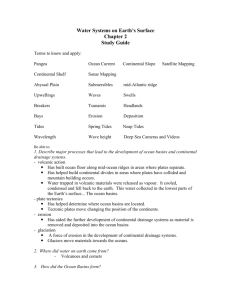The Oceans and Atmosphere
advertisement
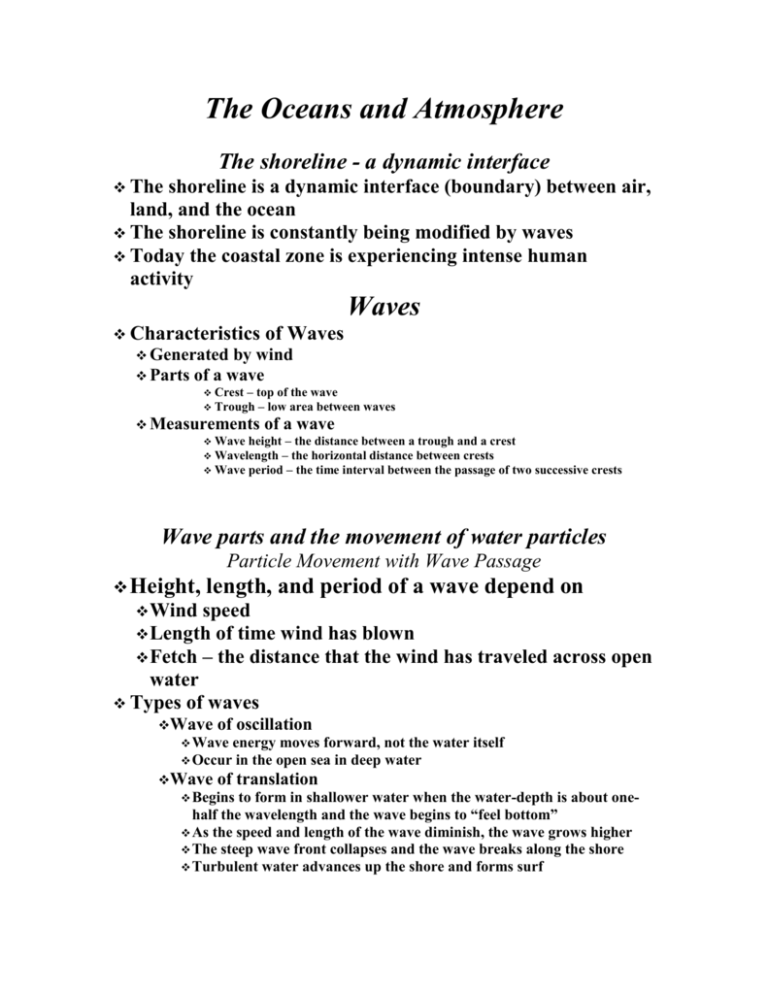
The Oceans and Atmosphere The shoreline - a dynamic interface The shoreline is a dynamic interface (boundary) between air, land, and the ocean The shoreline is constantly being modified by waves Today the coastal zone is experiencing intense human activity Waves Characteristics of Waves Generated by wind Parts of a wave Crest – top of the wave – low area between waves Trough Measurements of a wave height – the distance between a trough and a crest Wavelength – the horizontal distance between crests Wave period – the time interval between the passage of two successive crests Wave Wave parts and the movement of water particles Particle Movement with Wave Passage Height, length, and period of a wave depend on Wind speed Length of time wind has blown Fetch – the distance that the wind has traveled across open water Types of waves Wave of oscillation Wave Occur Wave energy moves forward, not the water itself in the open sea in deep water of translation Begins to form in shallower water when the water-depth is about onehalf the wavelength and the wave begins to “feel bottom” As the speed and length of the wave diminish, the wave grows higher The steep wave front collapses and the wave breaks along the shore Turbulent water advances up the shore and forms surf Changes that occur when a wave moves onto shore Wave erosion Breaking waves exert a great force Wave erosion is caused by Wave impact and pressure Abrasion by rock fragments Cliff undercut by wave erosion along the Oregon coast Wave refraction and longshore transport Wave refraction Bending of a wave Causes waves to arrive nearly parallel to the shore Consequences of wave refraction Wave energy is concentrated against the sides and ends of headlands If the shoreline remains stable, the result of shoreline erosion and deposition is to eventually produce a straighter coast Refraction of waves Wave refraction and longshore transport Wave refraction Moving sand along the beach Oblique waves also produce longshore currents in the surf zone Flow parallel to the coast Easily moves fine suspended sand and rolls larger sand and gravel along the bottom Currents Movement of sand by longshore current Shoreline features Features The vary depending on several factors including rocks along the shore Currents Wave intensity Whether the coast is stable, sinking, or rising Features caused by wave erosion Wave-cut cliffs Wave-cut platform Features associated with headlands Sea arch Sea stack Wave Erosion Anacapa Island Sea stack Spit Features related to beach drift and longshore currents bar – a sand bar (spit) that completely crosses a bay Tombolo – a ridge of sand that connects an island to the mainland or another island Baymouth Tombolo Massachusetts coast Depositional features Shoreline features Barrier islands Mainly along the Atlantic and Gulf coasts Low ridges of sand that parallel the coast 3 to 30 kilometers offshore Probably form in several ways Barrier islands along the Texas coast Shoreline erosion problems Shoreline erosion is influenced by several local factors including Proximity to sediment-laden rivers Degree of tectonic activity Topography and composition of the land Prevailing wind and weather patterns Configuration of the coastline and near-shore areas Three 1. basic responses to erosion problems Building structures Jetties Usually built in pairs to develop and maintain harbors Extend into the ocean at the entrances to rivers and harbors Jetties prevent deposition in channels Three 1. basic responses to erosion problems Building structures Groins Built to maintain or widen beaches Constructed at a right angle to the beach to trap sand Three 1. basic responses to erosion problems Building structures Breakwater Barrier built offshore and parallel to the coast Protects boats from the force of large breaking waves Three 1. basic responses to erosion problems Building structures Seawall Barrier parallel to shore and close to the beach to protect property Stops waves form reaching the beach areas behind the wall Often the building of structures is not an effective means of protection Three 2. basic responses to erosion problems Beach nourishment The addition of large quantities of sand to the beach system Only an economically viable long-range solution in a few areas 3. Abandonment and relocation of buildings away from the beach An Underfed Beach After Beach Nourishment Contrasting the Atlantic and Pacific Coasts Shoreline erosion problems are different along the opposite coasts Atlantic and Gulf Coasts Broad, gently sloping coastal plains quiet regions Tectonically Contrasting Atlantic the Atlantic and Pacific Coasts and Gulf Coasts Development occurs mainly on the barrier islands (also called barrier beaches or coastal barriers) Barrier islands face the open ocean They receive the full force of storms Contrasting Pacific the Atlantic and Pacific Coasts Coast Relatively narrow beaches backed by steep cliffs and mountain ranges major problem is a significant narrowing of many beaches Shoreline erosion varies considerably from one year to the next largely because of the sporadic occurrence of storms A Emergent and submergent coasts Emergent coasts Develop because of uplift of an area or a drop in sea level Features of an emergent coast Wave-cut Wave-cut Submergent Caused cliffs platforms coast by subsidence of land adjacent to the sea or a rise in sea level Features of a submergent coast Highly irregular shoreline Estuaries – drowned river mouths Chesapeake Bay is a submergent coastline Tides Daily changes in the elevation of the ocean surface Causes of tides Tidal bulges are caused by the gravitational forces of the Moon, and to a lesser extent the Sun Tides are caused by gravitational forces of the Moon Spring and neap tides Spring tides Occur during new and full moons forces of the Moon and Sun are added together Especially high and low tides Large daily tidal range Gravitational The Moon and Earth during spring tides Spring and neap tides Neap tides Occur during the first and third quarters of the Moon forces of the Moon and Sun are offset Daily tidal range is least Gravitational The Moon and Earth during neap tides Other factors that influence tides Shape of the coastline Configuration of the ocean basin Tidal currents Horizontal flow of water accompanying the rise an fall of the tide Tidal currents Types of tidal currents current – advances into the coastal zone as the tide rises Ebb current – seaward-moving water as the tide falls Flood Areas affected by the tidal currents are called tidal flats Occasionally form tidal deltas Tidal flats and a tidal delta The Ocean Floor The vast world ocean Earth is often referred to as the water planet 71% of Earth’s surface is represented by oceans Continents and islands comprise the remaining 29 Northern Hemisphere is called the land hemisphere, and the Southern Hemisphere the water hemisphere Distribution of land and water Distribution of land and water Extra-Terrestrial Water Mapping the ocean floor Depth was originally measured by lowering weighted lines overboard (sounding) Echo sounder (also referred to as sonar) Sound navigation and ranging Invented in the 1920s Primary instrument for measuring depth Reflects sound from ocean floor Multibeam sonar Employs an array of sound sources and listening devices Obtains a profile of a narrow strip of seafloor Echo sounders (A) and multibeam sonar (B) Three major topographic units of the ocean floor Continental margins Deep-ocean basins Mid-ocean ridges Major topographic divisions of the North Atlantic Ocean Passive Continental margins Found along most coastal area that surround the Atlantic Ocean Not associated with plate boundaries Experience little volcanism and few earthquakes Features comprising a passive continental margin Continental Flooded shelf extension of the continent Varies greatly in width Gently sloping Contain important mineral deposits Some areas are mantled by extensive glacial deposits Features comprising a passive continental margin Continental slope Marks the seaward edge of the continental shelf steep structure Boundary between continental crust and oceanic crust Relatively Features comprising a passive continental margin Continental Found rise in regions where trenches are absent slope merges into a more gradual incline – the continental Continental rise Thick accumulation of sediment At the base of the continental slope turbidity currents deposit sediment that forms deep-sea fans Submarine canyons and turbidity currents Submarine canyons Deep, steep-sided valleys cut into the continental slope Some are extensions of river valleys Most appear to have been eroded by turbidity currents Turbidity currents Downslope movements of dense, sediment-laden water Deposits are called turbidites Turbidites are layered and exhibit graded bedding (decrease in sediment grain size from bottom to top) Submarine canyons are eroded by turbidity currents Active Continental margins Continental slope descends abruptly into a deep-ocean trench Located primarily around the Pacific Ocean Accumulations of deformed sediment and scraps of ocean crust form accretionary wedges An active continental margin Features of the deep-ocean basin Deep-ocean Long, trench relatively narrow features Deepest parts of ocean Most are located in the Pacific Ocean Sites where moving lithospheric plates plunge into the mantle Associated with volcanic activity The world’s major oceanic trenches Abyssal plains Likely the most level places on Earth Sites of thick accumulations of sediment found in all oceans Seamounts Isolated volcanic peaks Many form near oceanic ridges May emerge as an island May sink and form flat-topped seamounts called guyots Mid-ocean ridges Characterized by elevated topography, extensive faulting, and volcanic activity Interconnected ridge system is the longest topographic feature on Earth’s surface Along the axis of some segments are deep down-faulted structures called rift valleys Consist of layer upon layer of basaltic rocks that have been faulted and uplifted Coral reefs and atolls Coral reefs Constructed primarily from skeletal remains and secretions of corals and certain algae Confined largely to the warm, clear waters of the Pacific and Indian Oceans Examples of Coral Atolls islands – a continuous ring of coral reef surrounding a central lagoon Form on the flanks of a sinking volcanic island (hypothesis proposed by Charles Darwin) Coral Formation of a coral atoll Atolls in the Pacific Key Terms Chapter 12 Salinity Tides (ebb, flood, spring, neap) Tidal delta Waves, surf Longshore currents, transport Beach drift, beach erosion Wave-cut cliff Spit Baymouth bar Tombolo Barrier island Emergent coastline, elevated wave-cut terrace Submergent coastline, estuary Continental shelf, slope, rise Abyssal plain Mid-ocean ridge Reef Greenhouse effect Ozone layer Coriolis effect
